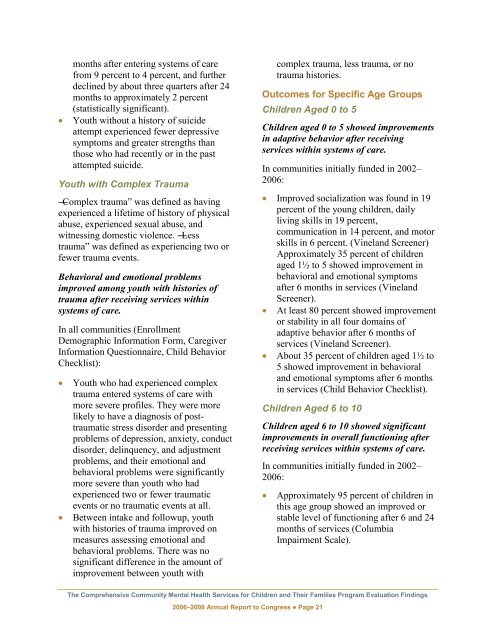Evaluation Findings - SAMHSA Store - Substance Abuse and Mental ...
Evaluation Findings - SAMHSA Store - Substance Abuse and Mental ...
Evaluation Findings - SAMHSA Store - Substance Abuse and Mental ...
You also want an ePaper? Increase the reach of your titles
YUMPU automatically turns print PDFs into web optimized ePapers that Google loves.
months after entering systems of care<br />
from 9 percent to 4 percent, <strong>and</strong> further<br />
declined by about three quarters after 24<br />
months to approximately 2 percent<br />
(statistically significant).<br />
Youth without a history of suicide<br />
attempt experienced fewer depressive<br />
symptoms <strong>and</strong> greater strengths than<br />
those who had recently or in the past<br />
attempted suicide.<br />
Youth with Complex Trauma<br />
―Complex trauma‖ was defined as having<br />
experienced a lifetime of history of physical<br />
abuse, experienced sexual abuse, <strong>and</strong><br />
witnessing domestic violence. ―Less<br />
trauma‖ was defined as experiencing two or<br />
fewer trauma events.<br />
Behavioral <strong>and</strong> emotional problems<br />
improved among youth with histories of<br />
trauma after receiving services within<br />
systems of care.<br />
In all communities (Enrollment<br />
Demographic Information Form, Caregiver<br />
Information Questionnaire, Child Behavior<br />
Checklist):<br />
<br />
<br />
Youth who had experienced complex<br />
trauma entered systems of care with<br />
more severe profiles. They were more<br />
likely to have a diagnosis of posttraumatic<br />
stress disorder <strong>and</strong> presenting<br />
problems of depression, anxiety, conduct<br />
disorder, delinquency, <strong>and</strong> adjustment<br />
problems, <strong>and</strong> their emotional <strong>and</strong><br />
behavioral problems were significantly<br />
more severe than youth who had<br />
experienced two or fewer traumatic<br />
events or no traumatic events at all.<br />
Between intake <strong>and</strong> followup, youth<br />
with histories of trauma improved on<br />
measures assessing emotional <strong>and</strong><br />
behavioral problems. There was no<br />
significant difference in the amount of<br />
improvement between youth with<br />
complex trauma, less trauma, or no<br />
trauma histories.<br />
Outcomes for Specific Age Groups<br />
Children Aged 0 to 5<br />
Children aged 0 to 5 showed improvements<br />
in adaptive behavior after receiving<br />
services within systems of care.<br />
In communities initially funded in 2002–<br />
2006:<br />
<br />
<br />
<br />
Improved socialization was found in 19<br />
percent of the young children, daily<br />
living skills in 19 percent,<br />
communication in 14 percent, <strong>and</strong> motor<br />
skills in 6 percent. (Vinel<strong>and</strong> Screener)<br />
Approximately 35 percent of children<br />
aged 1½ to 5 showed improvement in<br />
behavioral <strong>and</strong> emotional symptoms<br />
after 6 months in services (Vinel<strong>and</strong><br />
Screener).<br />
At least 80 percent showed improvement<br />
or stability in all four domains of<br />
adaptive behavior after 6 months of<br />
services (Vinel<strong>and</strong> Screener).<br />
About 35 percent of children aged 1½ to<br />
5 showed improvement in behavioral<br />
<strong>and</strong> emotional symptoms after 6 months<br />
in services (Child Behavior Checklist).<br />
Children Aged 6 to 10<br />
Children aged 6 to 10 showed significant<br />
improvements in overall functioning after<br />
receiving services within systems of care.<br />
In communities initially funded in 2002–<br />
2006:<br />
<br />
Approximately 95 percent of children in<br />
this age group showed an improved or<br />
stable level of functioning after 6 <strong>and</strong> 24<br />
months of services (Columbia<br />
Impairment Scale).<br />
The Comprehensive Community <strong>Mental</strong> Health Services for Children <strong>and</strong> Their Families Program <strong>Evaluation</strong> <strong>Findings</strong><br />
2006–2008 Annual Report to Congress ● Page 21

















